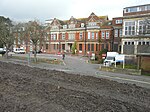Folkestone Triennial

The Creative Folkestone Triennial is an arts festival held every three years in Folkestone, Kent, England.Site-specific artworks are commissioned for what are often unusual locations around the town, a number of works remaining in place permanently after the end of each festival as part of the permanent Creative Folkestone Artworks exhibition. The 2021 Triennial will be the first to break the usual three-year cycle following a postponement from its original 2020 dates due to the global COVID-19 pandemic.Artists who have exhibited at the Triennial include Lubiana Himid, Tracy Emin, Cornelia Parker, Martin Creed, Myles Stephens, Emma Hart, Sir Anthony Gormley, Andy Goldsworthy and Bob and Roberta Smith. During 2014, graffiti artist Banksy contributed Art Buff to the town, announcing that it was "Part of the Folkestone triennial. Kind of."The Folkestone Triennial was curated by Andrea Schlieker in 2008 and 2011, and Lewis Biggs in 2014, 2017 and 2021.
Excerpt from the Wikipedia article Folkestone Triennial (License: CC BY-SA 3.0, Authors, Images).Folkestone Triennial
Shorncliffe Road, Folkestone and Hythe District Lynwood
Geographical coordinates (GPS) Address Nearby Places Show on map
Geographical coordinates (GPS)
| Latitude | Longitude |
|---|---|
| N 51.081 ° | E 1.166 ° |
Address
Shorncliffe Road 27
CT20 2NB Folkestone and Hythe District, Lynwood
England, United Kingdom
Open on Google Maps








